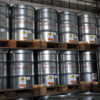The gold market continues to hold onto solid gains in the face of some renewed volatility, as inflation increases more than expected last month.
The Consumer Price Index (CPI) increased 0.2 per cent last month after August’s 0.2 per cent increase, according to the U.S. Bureau of Labour Statistics, released on Thursday. Economists were anticipating a 0.1 per cent increase.
Inflation rose 2.4 per cent over the last 12 months, a slight decrease from August’s 2.5 per cent annual increase. However, consumer prices remain slightly higher than expected, as economists had anticipated a rise of 2.3 per cent.
Inflation is also becoming more entrenched in the broader economy. The report shows that core inflation, excluding volatile food and energy prices, increased by 0.3 per cent in September, matching August’s rise. Economists had forecasted a smaller 0.2 per cent increase.
Over the year, annual core CPI climbed 3.3 per cent, exceeding the 3.2 per cent economists predicted.
Despite higher inflation, gold prices are trading near session highs. December gold futures last traded at USD$2,636.50 an ounce, up 0.4 per cent for the day. Some analysts highlight that the gold market has remained resilient in the face of rising consumer prices, as it hasn’t significantly impacted the Federal Reserve’s outlook on economic activity and inflation.
Economists also point to expectations that the labour market will weaken through 2025, which should help ease inflationary pressures.
The report highlighted a solid rise in shelter and food costs. The Shelter Index increased 0.2 per cent last month, while the Food Index rose 0.4 per cent. Together, these two indexes contributed to over 75 per cent of the monthly increase in all items.
Read more: Calibre intercepts long intervals of gold mineralization above resource grade
Read more: Calibre Mining finds higher gold rates at Marathon Pit
Energy index falls 6.8%
Consumers have also been benefiting from lower energy prices, as the energy index dropped 1.9 per cent last month, following a 0.8 per cent decline in August. For the year, the energy index has fallen 6.8 per cent.
“On the whole, despite the figures being hotter than expected, it seems highly unlikely that the September CPI figures will materially alter the Federal Office Market Committee (FOMC) policy outlook,” said Michael Brown, an senior market strategist at Pepperstone, a prominent Australian brokerage firm.
“With policymakers having already obtained sufficient confidence in a sustainable return towards the 2 per cent inflation target over the medium term, the labour market has now become the primary determinant of future policy shifts, with risks to each side of the dual mandate having come back into better balance.”
Brown expects the Federal Reserve to implement 25 basis point cuts at both of the remaining FOMC meetings this year, with further cuts continuing into 2025 until the federal funds rate reaches a neutral level around 3 per cent by next summer. He adds that if the labour market weakens significantly, potentially indicated by unemployment surpassing 4.4 per cent, the Fed could consider larger 50 basis point cuts.
Chris Zaccarelli, chief investment officer for Independent Advisor Alliance, noted that while inflation remains stubbornly high, the economy continues to show resilience.
“We think investors should be reassured that the economy is doing well, the labour market and consumer spending are both holding up well, and there doesn’t appear to be any signs of recession.”
Read more: Calibre Mining strikes gold: new high-grade discovery at Nicaragua’s Limon Mine
Read more: Calibre Mining shows analysts the ropes at the Valentine gold project
Gold futures have climbed despite inflation pressures
Inflation and economic policies have significant downstream effects on both gold investors and miners. For investors, gold is traditionally seen as a hedge against inflation, and elevated inflation typically increases demand for gold, driving prices higher.
Recently, gold futures have climbed despite inflation being hotter than expected, as investors look to gold for stability in uncertain times. However, if the Federal Reserve implements aggressive interest rate hikes to control inflation, it could have a negative impact on gold prices.
Higher interest rates increase the opportunity cost of holding non-yielding assets like gold, which might deter some investors.
For gold miners, inflation can squeeze profit margins by raising operational costs, especially in energy and labour.
However, miners that manage their costs effectively or have lower production costs can still benefit from higher gold prices during inflationary periods. Calibre Mining Corp. (TSE: CXB) (OTCMKTS: CXBMF), a mid-tier gold producer with operations in Nicaragua and Nevada and Canada, offers a good example of how miners are navigating this environment.
Calibre has focused on optimizing production and implementing technological innovations to control costs, allowing it to maintain healthy profit margins despite rising operational expenses. The company has benefited from strong gold prices while efficiently managing inflationary pressures.
Looking ahead, if inflation persists, gold investors may continue to see price support for gold as demand for safe-haven assets remains strong.
However, investor sentiment will likely shift depending on the Federal Reserve’s approach to interest rates. For gold miners, inflation’s impact on operational costs, particularly energy prices, remains a critical factor. Companies like Calibre Mining, which prioritize innovation and efficiency, are better positioned to thrive in such conditions.
.
Calibre Mining is a sponsor of Mugglehead news coverage
.
Follow Joseph Morton on Twitter
joseph@mugglehead.com













